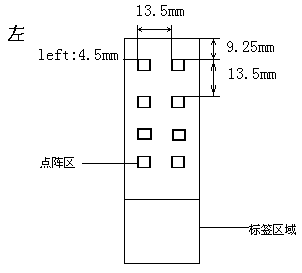Gene chip and detection kit for detecting common food allergens
A technology of gene chips and allergens, applied in the field of gene chips and detection kits containing the chips, can solve problems such as shortening the detection cycle, and achieve the effects of making up for the lack of detection range, accurate detection and identification, and rapid and accurate detection
- Summary
- Abstract
- Description
- Claims
- Application Information
AI Technical Summary
Problems solved by technology
Method used
Image
Examples
Embodiment 1
[0078] Example 1 Probe design and preparation
[0079] 1. Sequence acquisition:
[0080] The MTD gene of celery, the mitochondrial DNA of chicken, the mitochondrial 16s gene of fish, the Arah1 gene of peanut, the Sal gene of sesame, the Lectin gene of soybean (bean sprouts), the GAG56D gene of wheat, and the Pru dul gene of almond were downloaded from the GenBank public database.
[0081] 2. Example of probe design:
[0082] (1) MTD gene probe of celery: Import the MTD gene sequence of celery into Glustal X software, select a representative sequence and perform blastn comparison in the public data NCBI to determine whether it can be used as a specific target and the position of the specific target. Import the sequence into OligoArray2.0 software. The parameters were set as follows: -n 20; -l 30; -L 40; -D 3000; -t 79; -T 90; -s 65 °C; -x 65 °C; -N 2; ; -m GGGGG CCCCC TTTTT AAAAA ; -g 15. Run the program to design probes online.
[0083] 3. Probe synthesis: Extend t...
Embodiment 2
[0091] Example 2 Primer design and preparation
[0092] 1. Example of primer design:
[0093] The MTD gene of celery, the mitochondrial DNA of chicken, the mitochondrial 16s of fish, the Arah1 gene of peanut, the Sal gene of sesame, the Lectin gene of soybean (bean sprouts), the GAG56D gene of wheat, and the Pru dul gene of almond. Import MTD gene, chicken mitochondrial DNA, fish mitochondrial 16s, peanut Arah1 gene, sesame Sal gene, soybean (bean sprouts) Lectin gene, wheat GAG56D gene, almond Pru dul gene sequence into Glustal X software, and select one of them A representative sequence was imported into the Primer Primer 5.0 software, and the length was set to 70bp~10bp, the G+C% value was 40%~60%, Hairpin: NONE, Dimer: NONE, False Priming: NONE, Cross Dimer: NONE. And look for the nucleotide sequence region suitable for primer design, its characteristics basically meet the following conditions: 1, this region should contain a variable region that is easy to design s...
Embodiment 3
[0106] Example 3 Rapid detection of common food allergens and preparation of kits using gene chips
[0107] 1. Sample handling:
[0108] (1) Buy the food needed for the experiment at the vegetable market in Tianjin Binhai Development Zone
[0109] (2) Genome was extracted according to the procedure of the genome extraction kit of Dalian Bao Biological Company.
[0110] (3) Redissolve the genome, which can be used for detection or stored at -20°C.
[0111] Attachment: Kit name: Bao Bioengineering Company DNA Extraction Kit for GMO Detection Ver.2.0)
[0112] TaKaRa MiniBEST Universal Genomic DNA Extraction Kit Ver.4.0 from Treasure Biotech Co., Ltd.
[0113] 2. Amplify the target sequence: Take 3 ul of the supernatant extracted by the above genome extraction method as a template and add it to the PCR reaction mixture. The formula of the PCR reaction mixture is shown in Table 3 below. (Note: The PCR buffer, MgCl2, dNTP mixture, and Taq enzyme in the following T...
PUM
 Login to View More
Login to View More Abstract
Description
Claims
Application Information
 Login to View More
Login to View More - R&D
- Intellectual Property
- Life Sciences
- Materials
- Tech Scout
- Unparalleled Data Quality
- Higher Quality Content
- 60% Fewer Hallucinations
Browse by: Latest US Patents, China's latest patents, Technical Efficacy Thesaurus, Application Domain, Technology Topic, Popular Technical Reports.
© 2025 PatSnap. All rights reserved.Legal|Privacy policy|Modern Slavery Act Transparency Statement|Sitemap|About US| Contact US: help@patsnap.com



